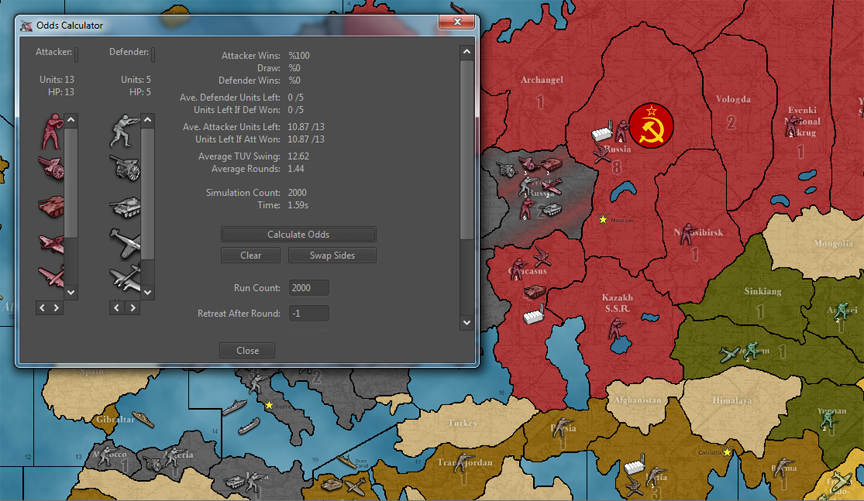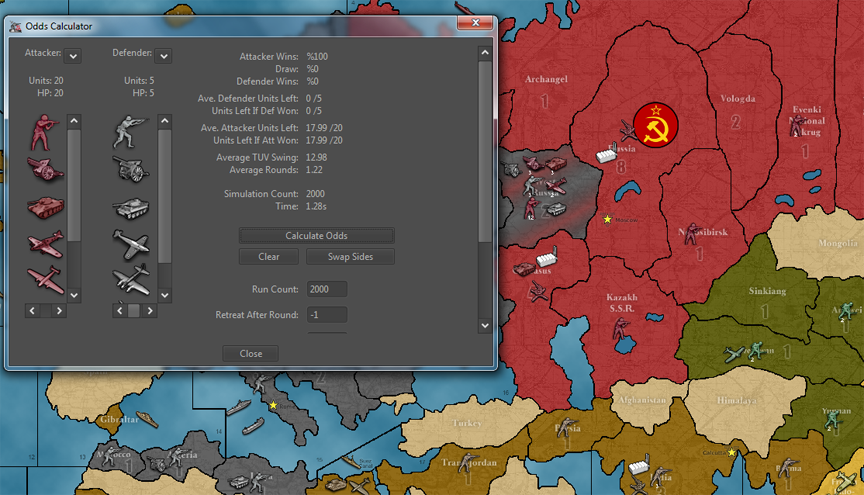(Pulled from another thread for safe keeping)
Still thinking about general strategies for the five player nations on this board, and building up to a German strategy guide little by little in my mind, but I wanted to pause this morning and just describe one Allied move that I’m rather fond of on this board with USA.
I’ve referred to it in the past as “the Iceland fighter transit”, or “the fighter launch” from sz 11 to Moscow in 2 moves.
Usually I will plan this move as a round 3 set up for USA, in KGF focused games. It is my favorite use for the starting US Pacific carrier in sz 53 (should this survive J1), if you want to move that Carrier from the Pacific to the Atlantic to support a European campaign. There are a number of purchases you can make during the first 3 rounds to support this play, I like to buy a destroyer and a carrier for sz 11 on USA1, but I just want to describe the situation here in terms of the starting units first.
The sz 53 fighter flies off the Carrier deck to land in W. Australia on USA1, then flies to India on USA2 for Calcutta defense.
The sz 53 fleet itself moves to sz 41, to guard the British as they make their way around South America (New Zealand evac). These ships are joined by the 1 fighter from Hawaii on USA1. This American fleet will move from sz 41 to sz 22 Brazil on USA2. The fighter can detach from the carrier on the second round, or stay with the deck in sz 22, it’s up to you. But I like to detach and fly from sz 41 either to W. Australia or Equatorial Africa/Congo so it can reach India the following round. Note if you take the Africa route for this fighter from sz 41, your flight path in round 3 is through Sudan, so it can land in India for defense.
Sz 41 is the fastest way to get the Hawaiian fighter to the Center/India that I’ve been able to find. It takes the same amount of moves as going any other direction. So I just go to sz 41 on USA1 with the Hawaiin fighter, and launch the fighter from there on USA2, with plans to land it in India on USA3. This is a better play I think, than going to Eastern Australia, or Central USA, or Alaska with the fighter from Hawaii on USA1.
The sz 56 fleet moves to sz 19 Panama on USA1, and on to sz 11 East Coast on USA2.
On round 3 you will purchase 2 USA fighters, to set up the Iceland transit in earnest. Whatever starting naval forces you purchased in the Atlantic up until this point, will converge with the British in sz 13 Morocco, to begin Operation Torch against North Africa. During this same 3rd round, your Pacific carrier will move to sz 11 on Non Com, where it will remain for the next several rounds to receive newly purchased fighters placed directly into sz 11. From this point on, the carrier deck will serve as a launching pad for newly purchased fighters on their way to Moscow/W.Russia via Iceland.The rest of your USA Atlantic forces are free to roam about and threaten amphibious landings, but this one carrier deck will remain in sz 11, to do its main job of fighter launching.
By the 3rd round USA will still be collecting into the high 30’s, usually between 36-38 ipcs. 20 of these ipcs will be dedicated to fighter purchases from round 3 on, which leaves a safe 16-18 ipcs for ground purchases (eventually more if USA can recover the lost income from China elsewhere on the map). What this means is that by round 3 you will want at least 3 transports, to move about 16-18 ipcs worth of ground out of North America every turn. If your starting transports somehow survive the initial German u-boat attack (or if Germany goes after the British instead) then you will begin play at advantage, if not these transports need to be replaced ASAP, for the purposes of moving ground towards fortress Europa.
The basic idea is this: on the 3rd round (and for many rounds thereafter) the USA will be purchasing 2 fighters a round, dropping them in sz 11, then flying to Iceland and from there directly to Moscow. This means 2 USA fighters in Iceland on round 4, which can land in Moscow/W. Russia on round 5. Or a fighter launch off your sz 11 carrier that is two rounds out from Moscow, for all newly purchased fighters from that point on (optimally 2 fighters, but at least 1 fighter per round, as income allows.)
Round 4, is when USA will take over the “Fighter Wall” purchasing role from UK, and provide direct fighter aid to Russia via the Iceland transit. This allows the British to begin purchasing Atlantic naval units, or to begin using the fighters they have purchased up until that point, for purposes beyond simple Moscow defense. In other words, the UK will make 3 rounds of Spitfire purchases to prop up Russia initially, after round 4 and beyond, it will be USA that takes over the job of sending fighters.
It is usually exactly around this time, that the UK’s total income will start to diminish to the point where fighter purchases are no longer viable for them. And it is also around this time that the German drive against Moscow will begin to make the UK to W. Russia/Archangel fighter transit less tenable. At precisely the point when the UK will have to start making serious compromises during their purchase units phase (e.g. when they need to start preparing for amphibious assaults vs Europe instead of Fighters to aid Russia) the USA will arrive from Iceland to take over and keep the center from collapsing.
It is possible to do this same move with a newly purchased USA carrier, instead of the Pacific sz 53 carrier. Or alternatively to use 2 carriers together in sz 11, to try and magnify the fighter launch, but I find that USA doesn’t have enough cash to make the most of a double deck launch in sz 11 (since that requires a minimum of 30 ipcs spent on 3 fighters to activate.) 1 carrier is usually enough, and the sz 53 Pacific carrier, is conveniently 3 rounds out from sz 11, giving USA two game rounds of purchasing to help set up the play. It is also possible to set an Iceland transit from the second round instead of the third, if you want to launch your 2 starting fighters off a newly purchased sz 11 carrier (bought on USA1), but this can stall your Torch options by a full round. It depends how urgent USA fighter support is to the defense of Moscow, but sometimes I will consider that play too.
On USA1 purchase, assuming Germany sank your starting transports, I enjoy 1 carrier (to be stacked with existing fighters) 1 destroyer, 2 transports. This is your “roaming carrier” the one that will be used for early Torch operations, and the two fighters that land on it will not be part of it the Iceland transit, but instead “glued” to this roaming deck for defense vs German air until later rounds. This leaves USA with a remainder of 6 ipcs. If Germany sank your transports with two U-boats surviving in sz 11, or if U-boats went for the double hit and destroyed the British in sz 10 as well, you might wish to spend that 6 ipcs on an additional Atlantic sub (for an extra fodder hit, which can be helpful in clearing the Atlantic.) Otherwise you can save that 6 ipcs for purchasing during the second round.
On USA2 purchase, I like 1 additional transport, 1 ground unit, and as many bombers as you can afford. This will give you a total of 4 loaded transports, or 2 alternating transports which can be used to launch at least 4 ground a round out of E. USA/Central USA into Africa. Some people call this a “Shuck.” If you plan a round in advance, this allows you to place 4 ground in W. USA for Japan defense, then move them to Central USA the following round, where they can load into sz 11.
The bombers, purchased in round 2, can rush to Moscow or India by round 4 to provide additional defensive fodder (wherever it is most needed). I like to make this bomber purchase early, as it will help to support subsequent fighter purchases on the Iceland transit, giving them more cumulative attack power. 20 ipcs a round will be dedicated to Iceland fighter launching, with the remainder spent on shucking ground into Africa, until you have secured the center/Moscow, and allowed the UK Atlantic fleet to become fully operational against Germany. At this point, you switch can switch from dedicated Iceland fighter purchases, to setting up the main expeditionary force for the Atlantic crossing (ie 1 less fighter per round, and more ground/transports to threaten amphibious.)
Optimally this will be between 3-6 newly purchased UK fighters (plus the starting fighters) to aid Russia/India in the first 3 rounds of game play. And then an additional 4-6 US fighters for that same purpose, during the next 3 rounds. Basically 6 rounds of dedicated fighter purchasing from the Allies to prop up the Russian capital and hold the Indian VC for as long as possible, while securing Africa/Suez in the process. In round 7, once the Moscow fighter wall is established (with two more US Iceland fighters on the way), you can start purchasing heavy ground rather than fighters for the main Atlantic crossing to set up the eventual hit on Berlin, and release the carrier from sz 11. A dozen or more Western Air units in Russia by the 7th round, to prevent the Axis from cracking the center, making an early Moscow crush an extremely bloody proposition for Germany. By maintaining control of the Center and Suez, the game changes from one that hinges entirely on the Russian capital to one that hinges on control of Berlin. Taking Berlin will secure the Allied endgame, regardless of whether Japan takes Moscow, so that is the race you will be playing, in proper KGF fashion.
The reason I like the Iceland fighter transit, is that it focuses on the movement advantage and overall power of the fighter unit, and gives you the fastest possible route to put USA fighters into Moscow: 2 rounds from sz 11. All the other transits to the Russian capital require a stop over in territories that Axis can threaten, or onto carriers in sea zones that Axis can threaten with air attacks. Iceland on the other hand is relatively secure. Iceland makes little sense for a UK Fighter transit, since you end up wasting too many movement points at too little advantage, but for a US fighter transit it is ideal. 4 spaces from sz 11 to Iceland, and another 4 spaces from Iceland to Moscow. So all you need to set it up is a carrier in sz 11.
One more tool in the toolbox! I don’t use it in every game, but it can be a lot of fun if you want to go fighter heavy with USA.
:-D








